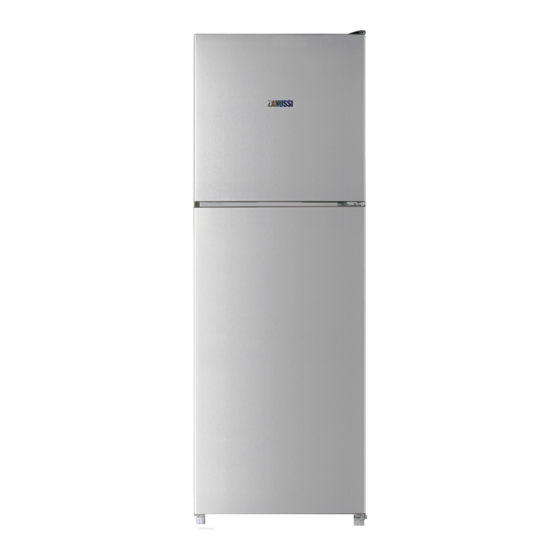Zanussi ZTB2500A-A Manuale di istruzioni - Pagina 5
Sfoglia online o scarica il pdf Manuale di istruzioni per Frigorifero Zanussi ZTB2500A-A. Zanussi ZTB2500A-A 8.

START
The temperature inside the refrigerator is controlled by the potentiometer installed in the fridge. The temperature inside
the refrigerator varies depending on the opening and closing doors of the refrigerator, the ambient temperature, and the
place of placement.
Under normal conditions, considering the food preservation and energy saving, in spring and summer, we recommend
user to adjust the fridge temperature to "MED".
In winter, the freezer can be adjusted to "MED" and "MAX".
During the actual use, the refrigerator air adjustment lever may get frozen as a result of high humidity or frequent opening
of the door. In such case, do not adjust the air lever by force; Instead, you are suggested to heat the air adjustment lever
locally using a hot towel to make the frozen air lever thaw before adjusting it, so as to avoid it from
being damaged.
Fridge temperature adjustment
1. When the fridge temperature adjustment knob from the "MAX" to the "MIN", the fridge temperature
gradually increased.
2. When you want to strengthen the fridge cooling, the fridge temperature adjustment knob to "MAX"
direction adjustment, so that the compressor running time will be extended, the fridge temperature will
be reduced accordingly.
Freezer temperature adjustment
1, When the freezer temperature control knob to remain in the same position, adjust the
settings freezer volume slider in position "MAX", will provide the greatest amount of freezing
cold, which leads to the lowest temperature in the freezing chamber.
2, When the freezer temperature control knob to remain in the same position, adjust the
settings freezer volume slider in position "MIN", will provide the minimum amount of cold freezer, which resulted in the
highest temperature in the freezing room.
IN USE
1.
The appliance might not operate consistently (possibility of defrosting of contents or temperature becoming too warm
in the freezer compartment) when sited for an extended period of time below the cold end of the range of
temperatures for which the refrigerating appliance is designed
2.
The information about the climate range of the appliance is provided on the rated plate.
3.
The fact that the internal temperatures could be affected by such factors as the location of the refrigerating appliance,
ambient temperature and the frequency of door opening, and, if appropriate, a warning that the setting of any
temperature control device might have to be varied to allow for these factors
4.
The fact that effervescent drinks should not be stored in freezer compartments or cabinets or in low-temperature
compartments or cabinets, and that some products such as water ices should not be consumed too cold
5.
The need to not exceed the storage time(s) recommended by the food manufacturers for any kind of food
Storage of food
1.
The cook dishes can be put into refrigerator to keep fresh after their temperature decreases to room temperature.
2.
Egg pockets and bottle pockets for eggs, butter, milk and bottle drinks, etc. Storage of food or containers should be
left between the gap, so as not to affect the air-conditioning cycle
3.
The arrangement of food for storage, in particular the need to avoid cross-contamination, such as food to be stored
should be wrapped with clean plastic film or fresh keeping paper, then distributed to several frames even to avoid
contamination and the loss of water and smell mixture.
4.
Fruits and vegetables should be put into the salad crisper to prevent excessive evaporation of water and freshness.
5.
Cool hot food down to the room temperature before storing otherwise consumption of electricity will increase and
would lead to frost forming inside.
6.
In the case of refrigerating appliances with chill compartment, a statement to the effect that some types of fresh
vegetables and fruits are sensitive to cold, and that therefore they are not suitable for storage in this kind of
compartment.
7.
The fact that effervescent drinks should not be stored in freezer compartments or cabinets or in low-temperature
compartments or cabinets, and that some products such as water ices should not be consumed too cold
Tips for keeping food perfect in the Fridge
1.
Cooked meats should always be stored on a shelf above raw meats to avoid bacterial transfer. Keep raw meats on a
plate which is large enough to collect juices and cover it with cling film or foil.
2.
This allows cold air to circulate around the Fridge, ensuring all parts of the Fridge are kept cool.
3.
To prevent transfer of flavors and drying out, food should be separately packed or covered. Fruit and vegetables
need not be wrapped.
4.
Allow pre-cooked food to cool down before placing in the Fridge. This will help to stop the internal temperature of the
Fridge from rising.
5.
To prevent cold air escaping, try to limit the number of times you open the door. When retuning from shopping, sort
foods to be kept in your Fridge before opening the door. Only open the door to put food in or take it out.
Interruption of power supply or failure of the refrigerating system
The care required with regards to frozen food in storage in the event of an extended non-running of the refrigerating
appliance (interruption of power supply or failure of the refrigerating system)
1.
Do not open the refrigerator door as much as possible so that even in hot summer food can be safely and freshly
kept for hours.
Classified as Internal
5
